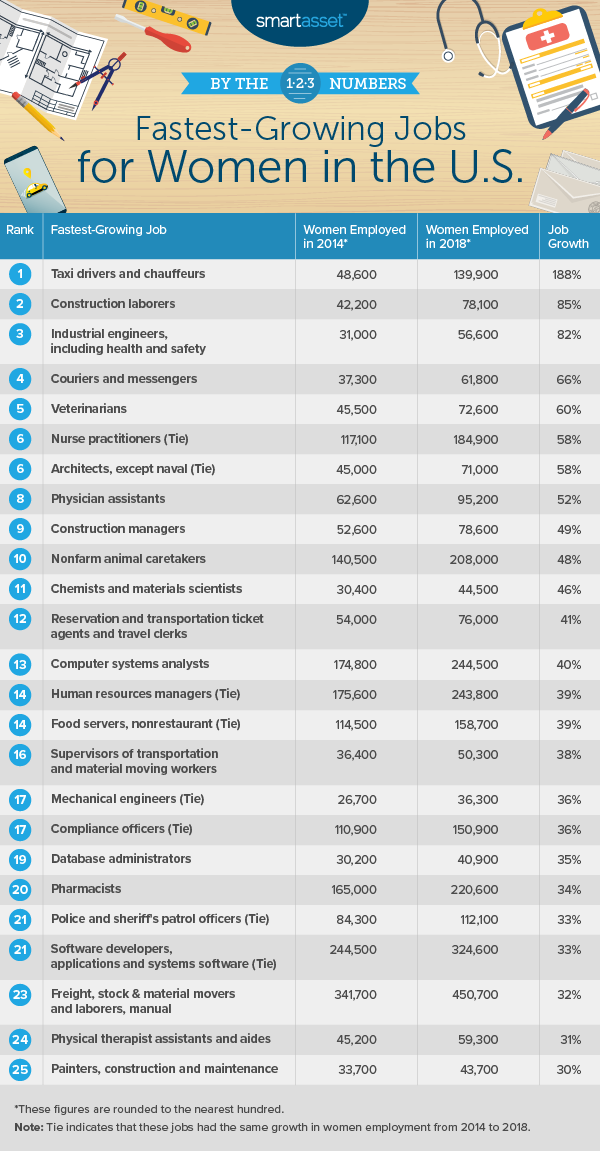
Women constitute nearly half of the workforce in the U.S. According to 2018 data from the Bureau of Labor Statistics (BLS), 46.9% of total workers are women, a figure that stayed constant from 2014 data. Despite the fact that the overall percentage remained unchanged over that time period, certain jobs and occupations in particular have seen significant growth for women, which in turn positively impacts their ability to save. These occupations include not only previously male-dominated jobs, but also other jobs for which the occupation overall is growing.
In this study, SmartAsset looked more closely at some of the fastest-growing jobs for women. Using BLS data from 2014 and 2018, we ranked percentage growth by occupation for occupations that employed greater than 25,000 women in 2014. We have contextualized this growth for the top 10 fastest-growing jobs for women, listed below, by highlighting the percentages of women and men employed in the occupation and the growth of the occupation overall. For more information on our data sources and how we put together our findings, check out our Data and Methodology section below.
Key Findings
- Flexible schedules. Some of our 10 fastest growing jobs offer more flexibility than typical nine-to-five positions. For instance, our top fastest-growing job, taxi drivers and chauffeurs, has become an increasingly less rigid occupation with the rise of ride-sharing applications. Drivers may adjust their schedules week to week and day to day according to their availability. The same is true for many couriers and messengers, the fourth-fastest-growing occupation for women.
- Construction and healthcare. Construction and healthcare are two of the most skewed industries by gender, with construction leaning heavily toward men and healthcare toward women. While increases in occupation growth between 2014 and 2018 worked to balance these industries, with construction growth being led by women and healthcare growth by men, they remain significantly skewed. In 2018, about 4% and 8% of construction laborers and construction managers, respectively, were women. In stark contrast, about 87% and 72% of nurse practitioners and physician assistants, respectively, were women.
- STEM jobs. Of our top 25 growing jobs for women, seven fall under the categories of science, technology, engineering and mathematics (STEM), fields that have often been predominantly male. The seven occupations include architects (except naval), industrial engineers, chemists and material scientists, computer systems analysts, mechanical engineers, database administrators and software developers (applications and systems). Each of these seven jobs saw more than a 30% increase in women employed from 2014 to 2018. Job-seekers looking to zero in on opportunities in these positions can target the best cities for women in tech.

1. Taxi Drivers and Chauffeurs
There were 394,000 more taxi drivers and chauffeurs in the U.S. in 2018 than there were in 2014, with the occupation more than doubling over five years. Largely the result of the increased prevalence and use of ride-sharing applications such as Uber and Lyft, taxi driver and chauffeur growth is in part driven by women drivers.
In 2014, there were roughly 48,600 women taxi drivers and chauffeurs in the U.S. Over five years, the number increased substantially. According to BLS data, in 2018 there were 139,900 women taxi drivers and chauffeurs, an increase of approximately 188% over that five-year period, or an annualized increase of more than 23%. In fact, the growth of women working as taxi drivers and chauffeurs far outpaces the growth of the occupation overall. In 2014, there were a total of 383,000 taxi drivers and chauffeurs in the U.S. and in 2018, there were 777,000, an increase of more than 102%, almost 85% less than the increase in women alone. Of course, on the downside, this category represents one of the occupations with the largest gender pay gap in the U.S.
2. Construction Laborers
Like growth for taxi drivers and chauffeurs, the growth of women construction laborers far outpaces the growth of the occupation for both men and women. Between 2014 and 2018, there was approximately an 85% uptick in women construction laborers. For the occupation overall, there was an increase of about 25%. This growth for women is particularly relevant for changing labor markets in the U.S., as there are a significant number of construction laborers. Compared to the other jobs in our top 10, there are almost twice as many construction laborers as any other occupation. In 2018, there were a total of 2,110,000 construction laborers in the U.S. The next occupation with the greatest number of workers in our top 10 is construction managers with 1,021,000 total workers in 2018.
Notably, while the number of women construction laborers has seen an increase over the past five years, the occupation remains largely male-dominated. In 2014, only 2.50% of construction laborers were women, and even with the 85% growth over the subsequent five years, in 2018 only 78,100, or 3.70% of the 2,110,000 total employed construction laborers, were women.
3. Industrial Engineers, including Health and Safety
In 2014, there were 31,000 women industrial engineers (including health and safety), according to estimates from the BLS. Between 2014 and 2018, approximately 25,600 more women were employed as industrial engineers so that in in 2018, there were a total of 56,600 women industrial engineers. In growth percentages, there was an increase of more than 82% over that five-year period.
Working to eliminate wastefulness in production processes, industrial engineers typically have a bachelor’s degree and are well compensated. According to the BLS, the median annual income for an industrial engineer in 2018 was $87,040.
4. Couriers and Messengers
The occupation of couriers and messengers has seen an increase of approximately 25% from 2014 to 2018, much of which is the result of women. In 2014, there were 37,300 women couriers and messengers in the U.S., and in 2018, there were 61,800. In terms of percentages, the number of women couriers and messengers increased by almost 66% over that period.
As noted previously, couriers and messengers may have more flexible schedules than other workers. However, this flexibility is accompanied by relatively low wages. BLS estimates from 2018 show that couriers and messengers have a median annual income of $28,720.
5. Veterinarians
Veterinarians is the first occupation on our list for which women constitute a larger percentage of the number of employed persons than men. In 2014, approximately 56% of veterinarians in the U.S. were women. With a growth of about 60% over the following five years, more than 71% of veterinarians in 2018 were women.
Unlike many of the other jobs we have previously discussed, veterinarians typically have advanced degrees. The BLS reports that the typical entry-level education for a veterinarian is a doctoral or professional degree. While this may deter some from entering the profession, one advantage is that veterinarians are also typically well compensated. In 2018, the median pay for a veterinarian in the U.S. was $93,830 per year, or $45.11 per hour.
6. Nurse Practitioners (tie)
Though the number of women employed in this occupation has grown approximately 58% – almost 68,000 more nurse practitioners – from 2014 to 2018, the percentage of women in this job among all employees saw a decrease of about five percentage points. This means that there has been a greater growth in male nurse practitioners than female practitioners during this period. In general, nurse practitioners should not be worried about job security looking forward. The BLS projects that the employment of nurse practitioners will grow more than five times faster than the average growth for all occupations. Not all places in the country are equally conducive to thriving as a nurse: Check out our study on the best places to be a nurse in the U.S.
6. Architects, except Naval (tie)
The 2014-to-2018 change in total number of women employed as architects (except naval architects) closely mirrors that of the change in the total number of women employed as industrial engineers over that time period. In 2014, about a quarter of these architects were women, and in 2018, almost 30% were women. In gross terms, in 2014 there were about 45,000 women architects in the U.S. and in 2018 there were about 71,000. For architects who want to be surrounded by other likeminded people, check out the top places for creatives.
8. Physician Assistants
Both nurse practitioners and physician assistants are mid-level healthcare practitioners who provide patient-centered care. However, physician assistants are more likely to work in specialized practice areas than nurse practitioners are. For instance, according to the American Association of Physician Assistants, 25% of physician assistants have a general surgery specialty or surgical subspecialty.
Between 2014 and 2018, there was an increase of approximately 52% in women physician assistants. As with nurse practitioners, growth of male physician assistants outpaces growth of female physician assistants. The occupation overall grew by about 57%. However, according to the BLS, women are likely to earn more than men in both occupations.
9. Construction Managers
Like our No. 2 job on this list, construction laborers, construction managers are mostly men. Despite an approximately 49% increase in women construction managers over the five-year period from 2014-2018, only about 8% of all construction managers in the U.S. in 2018 were women. However, in gross terms, the number of women construction managers employed in 2018 is large, as there are a large total number of construction managers as well. There were 78,600 women construction managers of a total 1,021,000 construction managers employed last year. Relative to the other occupations in our top 10, it is the second-largest occupation behind construction laborers.
Construction managers earn significantly more than construction laborers. In 2018, the median annual income for construction managers was $93,370 while the median annual income for construction laborers was $34,810.
10. Nonfarm Animal Caretakers
Nonfarm animal caretakers feed, groom, exercise or otherwise care for animals such as dogs and cats, as well as zoo animals. Unlike veterinarians, however, nonfarm animal caretakers do not typically have advanced degrees. In general, they also earn less than veterinarians.
Like nurse practitioners and physician assistants, women nonfarm animal caretakers comprised at least two-thirds of all people employed in that job in 2018. In 2014, approximately 70% of nonfarm animal caretakers were women, and in 2018, about 78% were women. Over that five-year period, the growth for women was about 48% – or about 67,500 jobs – compared to an overall growth of 33.3% for both men and women during that time period.
Data and Methodology
To find the fastest-growing jobs for women, SmartAsset looked at employment data from 2014 and compared it to 2018. We filtered out any occupation that employed less than 25,000 women in 2014. We also filtered out any occupation with “other” in the title. To rank the occupations, we looked at the percent change in women employed in each occupation from 2014 to 2018.
All data, including earnings data, comes from the Bureau of Labor Statistics. Employment data is reported to the nearest hundred.
Tips for Saving for Retirement
- Smarter savings. As you grow your career, it’s important to grow your savings as well in order to make sure you have enough set aside for your future. Take advantage of your employer’s 401(k) match if available, and use a comprehensive retirement calculator to get a sense of what your situation might look like.
- Invest in professional insight. You may be an expert in your career, but that doesn’t mean you know the best way to grow your money through smart investing. Consider seeking the advice of an expert advisor to help you make the most of your hard-earned money. Finding the right financial advisor that fits your needs doesn’t have to be hard. SmartAsset’s free tool matches you with financial advisors in your area in 5 minutes. If you’re ready to be matched with local advisors that will help you achieve your financial goals, get started now.
Questions about our study? Contact us at press@smartasset.com
Photo credit: ©iStock.com/Hiraman